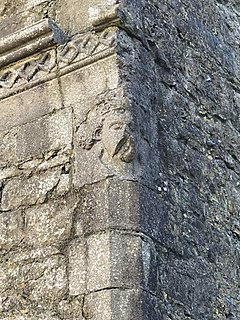| |||||
| Centuries: | |||||
|---|---|---|---|---|---|
| Decades: | |||||
| See also: | Other events of 1194 List of years in Ireland | ||||
Events from the year 1194 in Ireland.
| |||||
| Centuries: | |||||
|---|---|---|---|---|---|
| Decades: | |||||
| See also: | Other events of 1194 List of years in Ireland | ||||
Events from the year 1194 in Ireland.

Connacht, or Connaught, is one of the provinces of Ireland, in the west of Ireland. Until the ninth century it consisted of several independent major Gaelic kingdoms.

The House of de Burgh, Burke or Bourke was an ancient Anglo-French family with the Anglo-Irish branches later adopting the surname Burke and its variants.

William de Burgh ; c.1160–winter 1205/06) was a member of the House of de Burgh and founder of the House of Burke in Ireland.

Richard Mór de Burgh, 1st Lord of Connacht, was a Hiberno-Norman aristocrat and Justiciar of Ireland.

Walter de Burgh, 1st Earl of Ulster, 2nd Lord of Connaught, also spelt Bourke or Burke, was an Irish peer from the House of Burke.
Sir William Óg de Burgh was an Anglo-Irish noble and soldier.
The Burke/de Burgh Civil War was a conflict in Ireland in the 1330s between three leading members of the de Burgh (Burke/Bourke) Anglo-Norman family.

Sir Uilleag (Ulick) de Burgh or Burke, 1st Clanricarde was the leader of one of the three factions who fought the Burke Civil War in the 1330s. By the end of the conflict he had established himself and his descendants as Clanricarde, also known as the Mac William Uachtar, independent lords of Galway. He was succeeded by his son, Richard Óg Burke.

Clanricarde, also known as Mac William Uachtar or the Galway Burkes, were a fully Gaelicised branch of the Norman originated House of Burke in Ireland. The term was important in Ireland from the 13th to the 20th centuries.

Cathal Crobhdearg Ua Conchobair (1153–1224), was a king of Connacht. He was the youngest son of the High King of Ireland Tairrdelbach Ua Conchobair and brother to the last fully recognized High King Ruadri Ua Conchobair. His own sons Aedh Ua Conchobair and Feidhlimidh Ua Conchobair were kings of Connacht after him.
The title of Lord of Connaught was used by several Norman barons in Ireland.
Events from the year 1224 in Ireland.
Events from the 1230s in England.
Events from the year 1242 in Ireland.
Egidia de Lacy, Lady of Connacht, was a Cambro-Norman noblewoman, the wife of Richard Mór de Burgh, 1st Baron of Connaught and Strathearn (c.1194–1242), and the mother of his seven children, including Walter de Burgh, 1st Earl of Ulster. She was also known as Gille de Lacy. Egidia was the daughter of Walter II de Lacy by his second wife Margaret de Braose.
Conchobar Ó Cellaigh, 43rd King of Uí Maine and 10th Chief of the Name, died 1268.
William Liath de Burgh, magnate and deputy Justiciar of Ireland, died 1324.

Mac William Íochtar, also known as the Mayo Burkes, were a fully Gaelicised branch of the Hiberno-Norman House of Burke in Ireland. The territory covered much of the northern part of the province of Connacht. The Mac William Íochtar functioned as a regional king and received the White Rod. The title was a successor office to the Lord of Connacht which ended upon the assassination of William Donn de Burgh, 3rd Earl of Ulster, in June 1333.
Richard Óg de Burgh, Anglo-Irish noble and soldier, ancestor of Burke of Clanricarde, fl. early-to-mid 13th century.

Richard Óg de Burgh, 2nd Earl of Ulster and 3rd Baron of Connaught, called The Red Earl, was one of the most powerful Irish nobles of the late 13th and early 14th centuries.